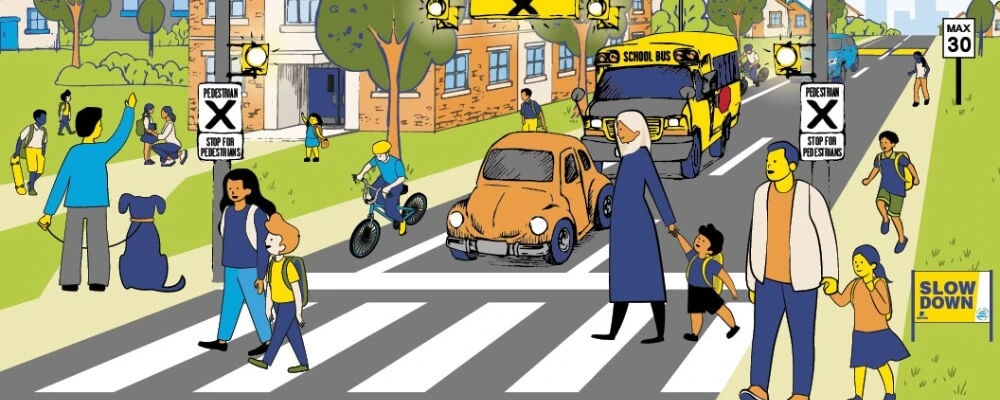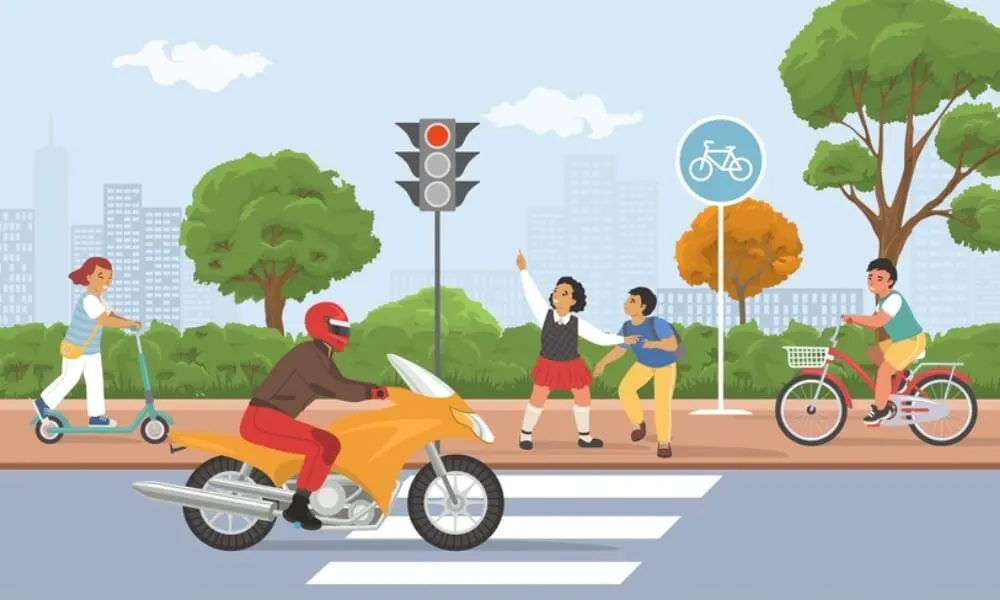Road safety remains paramount for individuals and communities in an ever-evolving urban landscape. Ensuring the well-being of every road user, from the exuberant child crossing the street to the seasoned driver navigating rush hour, is a shared responsibility. The significance of road safety transcends age groups, demanding holistic approaches that cater to the unique needs of each demographic.
Our comprehensive guide delves deep into tailored initiatives, programs, and strategies that resonate with different age brackets. From playful, educational activities for children to refresher courses for seniors, this article underscores the importance of a collective approach to road safety. Join us on this enlightening journey and discover how to make our roads safer.
Road Safety Activities
Road safety activities refer to the various initiatives, programs, training sessions, and awareness campaigns designed to educate and inform individuals and communities about the importance of safe behaviors on the road.
These activities aim to prevent accidents, minimize injuries, and save lives. They encompass various actions, from pedestrian training for children to defensive driving courses for new drivers and public awareness campaigns targeting the broader community.
Importance of Road Safety Activities:
- Reduction of Accidents and Fatalities: At their core, road safety activities aim to reduce the number of accidents on the road. By educating individuals about safe driving behaviors and pedestrian practices, the risks associated with road travel can be significantly minimized.
- Promotion of Safe Behaviors: Consistent messaging and training instill safe habits in individuals. Over time, behaviors like wearing seat belts, following speed limits, and not using phones while driving have become second nature.
- Economic Impact: Road accidents can have significant economic repercussions. The economic burden of unsafe roads is vast, From direct costs related to vehicle repairs and medical bills to indirect costs like traffic jams, lost productivity, and the strain on emergency services. Road safety activities help alleviate these costs.
- Protection of Vulnerable Road Users: Certain groups, such as children, older people, and cyclists, are particularly vulnerable on the roads. Targeted road safety activities ensure that these groups receive special attention, ensuring their safety.
- Building a Safety-conscious Community: Road safety isn’t just the responsibility of individual drivers; it’s a community effort. Activities that engage the broader community, from schoolchildren to senior citizens, create an environment where road safety is a collective priority.
- Addressing Modern Challenges: With the evolution of technology, new challenges, like the rise of distracted driving due to smartphones, have emerged. Road safety activities adapt to these new challenges, ensuring the public knows and is equipped to handle modern road risks.
- Legal and Policy Implications: Continuous road safety advocacy can influence policymakers. A community prioritizing road safety can enact stricter traffic laws, better road designs, and more significant enforcement efforts.
Road safety activities are paramount in fostering a culture of responsibility and caution on the roads. They directly save lives and contribute to healthier, more informed, and cohesive communities.
Comprehensive Road Safety Activities for Every Age Group
Promoting road safety is essential to reduce accidents and save lives. Road safety activities should be tailored to different age groups to ensure maximum impact. Here are comprehensive road safety activities for various age groups:

1. Road Safety Activities For Children
Teaching road safety to children is crucial to help them become responsible and safe pedestrians and future drivers. Here are some road safety activities for children that can be both fun and educational:
1. Safety Storytelling
The power of storytelling is immense, especially when teaching young minds. Educators can make complex lessons more relatable and memorable for children by weaving road safety principles into tales. These stories could be sourced from books or crafted originally, based on real-life events, or purely from imagination. Central to these narratives should be characters that children can relate to who navigate various road-related challenges.
These stories’ climaxes or endings should emphasize the consequences of their good or bad decisions. To add a touch of modernity and enhance engagement, multimedia elements like animated videos or audio narrations can be incorporated. This multimedia approach caters to children’s diverse learning styles, ensuring that the road safety message resonates with all.
2. Safety Role Play
Role-playing is an effective method for children to understand and internalize road safety behaviors. By setting up a simulated road environment, children are given a platform to act out real-life roles such as pedestrians, drivers, or traffic police officers.
This dynamic play, where they switch roles, gives them a holistic understanding of each road user’s responsibilities. To further immerse the children in the experience, props like toy cars, bicycles, and traffic signs can be added, giving a touch of realism to the mock scenarios.
3. Pedestrian Training
One of the primary road interactions for children is as pedestrians. Therefore, teaching them the basics of safely navigating the roads on foot is crucial. By recreating a controlled environment that mimics real-world road scenarios, children can be trained on using pedestrian crossings, understanding the meaning of different traffic light signals, and the vital importance of not impulsively running onto roads.
A more advanced level of this training could involve introducing unpredictable elements, such as a ball suddenly rolling onto the road. Such situations teach children to always be alert and expect the unexpected.
4. Coloring and Drawing
Art, especially coloring and drawing, offers a unique platform for children to express their understanding of road safety. By providing them with coloring sheets that depict various road scenarios, educators can engage children in a fun activity while initiating conversations about the safe behaviors illustrated.
Taking this a step further, organizing a drawing competition centered around road safety can stoke creativity while driving home the importance of the theme.
5. Safety Song and Dance
Music and movement are universal languages that resonate with children. Crafting catchy jingles and dances that emphasize road safety themes can make these lessons memorable. By leveraging familiar tunes and overlaying them with safety-focused lyrics, educators can create a resource that children will likely hum and remember.
An even more engaging approach would be to host a mini concert where children can proudly showcase the road safety songs and dances they’ve learned.
6. Safety Puzzles and Games
Games naturally stimulate the mind and challenge thinking. Introducing safety-themed puzzles and board games can be an indirect yet powerful method of instilling road safety principles. For instance, a simple memory card game where children have to match traffic signs can sharpen their recall and recognition skills. Over time, this repeated exposure ensures they recognize these signs effortlessly in real-world scenarios.
7. Traffic Sign Recognition
Traffic signs are visual cues designed to communicate vital road information quickly. Introducing children to these signs, explaining their meanings, and later quizzing them on their recall serves a dual purpose. It boosts their observational skills and ensures they can interpret these signs correctly, laying the foundation for when they eventually become drivers.
8. Interactive Digital Apps
In today’s digital age, leveraging technology for education is a given. Numerous apps and computer games simulate road environments and challenge players, requiring them to make safe choices to progress. By introducing children to such platforms, they can learn vital road safety lessons in a familiar, interactive, and enjoyable format.
Educators can seamlessly integrate road safety lessons into children’s daily routines by consistently implementing these activities. The combination of repetition, variety, and engaging formats ensures that road safety becomes second nature to them as they grow.

2. Road Safety Activities For Teens
Promoting road safety among teens is crucial to reduce accidents and fatalities. Here are some road safety activities and initiatives specifically designed for teenagers:
1. Defensive Driving Course
As teenagers start to get behind the wheel, it becomes essential for them to understand not only the mechanics of driving but also the mindset needed to anticipate potential dangers. A defensive driving course is a comprehensive training program that educates young drivers on hazards and the best strategies to avoid them.
Beyond just following traffic rules, the course focuses on reading the behavior of other drivers, understanding the importance of environmental conditions, and mastering techniques to evade dangerous situations.
2. Virtual Reality (VR) Simulations
Modern technology provides a fantastic platform for teens to learn and practice driving in a safe, controlled environment. Using VR headsets, teens can immerse themselves in hyper-realistic driving scenarios.
These simulations can range from everyday driving conditions to more challenging situations, like driving in rain or fog. The beauty of VR is that it allows teens to make mistakes and learn from them without real-world consequences, thereby bolstering their confidence and skills before they hit the open road.
3. Discussion Sessions
Open dialogues about road safety are crucial for teens often influenced by peer behaviors. By arranging discussion sessions, educators or facilitators can provide a platform where teenagers can openly share their experiences, concerns, and perceptions about driving.
Topics like the repercussions of texting and driving, driving under the influence, and the importance of seat belts can be addressed. These discussions can be augmented with real-life case studies, statistics, and videos to drive the message home.
4. Mock Checkpoints
Organizing mock DUI (Driving Under the Influence) checkpoints in school or community parking lots can be an eye-opening experience. Here, teens undergo simulated sobriety tests and are educated about the effects of alcohol and drugs on driving abilities. This hands-on experience can be impactful in dissuading them from making dangerous choices.
5. Vehicle Maintenance Workshops
Understanding the workings of a car is vital for every driver. Organizing workshops where teens can learn basic vehicle maintenance tasks like checking tire pressure, understanding dashboard warning lights, and refilling fluids can make them more responsible drivers. It ensures they know the importance of a well-maintained vehicle in ensuring road safety.
6. Peer-to-Peer Education Programs
Often, messages from peers resonate more with teens than advice from adults. Initiating peer-to-peer road safety education programs where trained teen ambassadors deliver safety messages to their mates can be highly effective. The authenticity of a peer sharing personal experiences and learning tends to be more impactful.
7. Safety Campaign Projects
Encourage teens to start road safety campaigns within their schools or communities. They can create posters, social media campaigns, or organize events. Researching and promoting road safety can be a powerful learning experience.
As teenagers are at a stage where they are forming their driving habits, these activities aim to instill a sense of responsibility, caution, and awareness, ensuring they become safe and responsible drivers.

3. Road Safety Activities For Adults
Promoting road safety among adults is essential to reduce accidents and save lives. Here are some road safety activities and tips tailored for adults:
1. Public Awareness Campaigns
Adults, constantly on the move and engrossed in their routines, often benefit from reminders placed directly in their line of sight. Public awareness campaigns leverage various mediums to relay crucial road safety messages. Posters and billboards placed strategically at intersections, bus stops, and highways can provide stark reminders about the perils of speeding, the importance of seat belts, and the dangers of texting while driving.
Social media campaigns can amplify these messages in today’s digital age. Adults can be continually educated about adopting safer road behaviors through compelling visuals, testimonials, and statistics on platforms like Facebook, Instagram, and Twitter.
2. Driving Refresher Courses
Over time, even seasoned drivers can develop complacent or incorrect driving habits. Driving refresher courses are designed to address this issue. These courses not only brush up on the basic rules of the road but also introduce drivers to new traffic regulations and provide updates on best driving practices.
By putting adults back in the student’s seat, these courses rejuvenate their driving skills, making them more attentive and better equipped to handle modern road challenges.
3. Workshops
Dedicated workshops can be instrumental in drilling down on specific road safety topics. For instance, a workshop on drunk driving might cover the physiological effects of alcohol on the body, the legal implications of DUI (Driving Under the Influence), and share heart-wrenching testimonials from families affected by drunk driving incidents.
Similarly, a workshop on motorcycle safety could delve into the importance of helmets, protective gear, and defensive riding techniques. These focused sessions, often accompanied by practical demonstrations and interactive discussions, can leave a lasting impression on the participants.
4. Road Safety Seminars
Organize seminars featuring experts like traffic police officers, vehicle safety experts, or accident survivors. These speakers can provide insights on the latest traffic regulations, share statistics on road accidents, and provide firsthand accounts of the implications of unsafe driving. The formal seminar setting combined with expert knowledge can drive the message effectively.
5. Interactive Drives
Set up controlled environments where adults can experience the dangers of certain behaviors firsthand without real-world consequences. For example, a simulated drive while wearing goggles that mimics the effects of intoxication can give participants a tangible understanding of why drunk driving is dangerous.
6. Safety Tech Demonstrations
With cars now equipped with advanced safety technologies like adaptive cruise control, lane-keeping assists, and automatic emergency braking, adults must understand how to use them.
Organize demonstrations or hands-on sessions where adults can learn about these features, ensuring they utilize the safety tech in their vehicles to its full potential.
7. Community Engagement Programs
Engage local communities by initiating road safety weeks or monthly safety drills. Encourage community members to share personal experiences, distribute safety materials, or even volunteer for local traffic management to see firsthand the challenges and importance of road safety.
By addressing adults, who make up a significant portion of the driving population, these activities aim to ensure that seasoned drivers remain updated and informed and always prioritize road safety.

4. Road Safety Activities For Seniors
Promoting road safety activities for seniors is essential to help them maintain their independence and ensure their safety on the road. Aging can bring about physical and cognitive changes that may affect driving abilities, so addressing these issues through education, awareness, and alternative transportation options is crucial. Here are some road safety activities and tips for seniors:
1. Vision and Hearing Tests
As people age, physiological changes can impact their vision and hearing, which are fundamental for safe driving. Regular vision tests can detect common age-related issues such as cataracts, glaucoma, or macular degeneration, ensuring they are addressed timely.
Similarly, hearing tests can identify any loss of hearing that might affect a senior’s ability to hear sirens, horns, or other crucial auditory cues while on the road. By ensuring these senses are in optimal condition, or that necessary corrective measures (like glasses or hearing aids) are used, seniors can maintain their driving competency for longer.
2. Refresher Driving Lessons
Driving dynamics have evolved over the decades with newer road rules, traffic patterns, and vehicle technologies. Refresher driving lessons tailored for seniors can address these changes, ensuring they remain confident and skilled drivers.
More than just rules, these lessons can also incorporate techniques that compensate for age-related physical changes, such as reduced neck mobility, slower reflexes, or diminished strength. Adapting driving techniques to these changes can help seniors drive safely.
3. Information Sessions
One of the seniors’ most challenging decisions is recognizing when it might be time to reduce or stop driving. Information sessions can provide objective criteria and self-assessment tools to help seniors evaluate their driving capabilities.
These sessions can discuss this decision’s emotional and practical aspects, ensuring seniors understand it’s about safety rather than independence. Additionally, these sessions can introduce alternative transportation options, such as community shuttle services, public transit, or rideshare programs tailored for seniors.
4. Vehicle Adaptation Workshops
As seniors face physical challenges, their vehicles can be adapted to accommodate these changes. Workshops can showcase adaptive equipment like steering wheel covers for better grip, extended mirrors for broader vision, or seat cushions for better posture and visibility. Understanding and using these adaptations can enhance driving comfort and safety.
5. Physical Fitness Programs
Physical fitness plays a vital role in driving capabilities. Organizing fitness programs focusing on improving strength, flexibility, and coordination can benefit seniors in their driving tasks. For instance, exercises that enhance neck flexibility can make checking blind spots easier.
6. Road Safety Peer Groups
Creating peer groups where seniors can discuss their driving experiences, challenges, and fears can be therapeutic. These group discussions can serve as a platform for sharing tips, voicing concerns, and collectively seeking solutions.
7. Public Transport Familiarization Tours
Seniors transitioning from driving to using public transport might need guidance. Organizing tours where seniors can get acquainted using buses, trams, or trains can make this transition smoother. It helps them understand schedules, ticketing systems, and other nuances, making them confident public transport users.
Addressing seniors’ unique challenges regarding road safety ensures they remain competent and confident road users while recognizing when alternative transportation might be a safer choice.

5. Road Safety Activities For the General Public
Promoting road safety is essential to reduce accidents and save lives. Here are some road safety activities that can be undertaken by the general public:
1. Seat Belt Demonstrations
Seat belts are a vehicle safety tool, yet many often neglect their importance. Demonstrations using crash test dummies can vividly showcase the difference between the impacts endured with and without seat belts.
These demonstrations, either live or through videos, graphically illustrate the severe injuries or fatalities resulting from not wearing a seat belt. Witnessing the sheer force and repercussions can serve as a stark reminder and advocate for the consistent use of seat belts.
2. Road Safety Workshops
General car maintenance is not just about vehicle longevity but also directly impacts safety. Workshops targeting the general public can cover crucial topics such as checking tire treads and pressure, ensuring brakes function optimally, and understanding the importance of safe following distances.
Such workshops can provide hands-on experience, allowing attendees to perform these checks themselves, ensuring they can routinely do the same for their vehicles.
3. Public Service Announcements (PSAs)
Mass media plays a pivotal role in shaping public behavior. Periodic PSAs broadcasted on television, radio, or online platforms can be timely reminders about various road safety aspects.
These announcements, often short yet impactful, can cover topics ranging from the perils of drunk driving to the importance of using indicators. Their recurrent nature ensures that road safety remains at the forefront of public consciousness.
4. Checkpoints
Police checkpoints, especially during times known for increased alcohol consumption, like festive seasons or public holidays, act as both a deterrent and a protective measure. By randomly screening drivers for alcohol levels, they not only dissuade individuals from drunk driving but also catch potential offenders, thus ensuring safer roads.
The mere knowledge that checkpoints exist can deter many from making the risky choice of driving under the influence.
5. Interactive Road Safety Exhibitions
Organizing exhibitions where attendees can experience various interactive stalls related to road safety can be highly effective. These can include VR simulations of dangerous driving scenarios, displays of the latest vehicle safety technologies, or even firsthand testimonies from accident survivors.
6. Drive Safe Challenges
Introduce challenges where individuals or groups pledge to drive safely for a certain duration, adhering to all road safety norms. Incorporating gamification providing rewards or recognition for those who successfully complete the challenge can encourage more participation.
7. Collaborative Community Initiatives
Engage local communities in road safety projects. This can involve initiatives like painting pedestrian crossings, installing community-funded speed limit signs, or organizing local road safety awareness events.
8. Feedback Stations
Set up stations in public areas where individuals can provide feedback on specific road safety issues they face in their localities. This could be related to the need for speed bumps, better lighting, or pedestrian crossings. Involving the public in road safety decisions can lead to more community-driven solutions.
By actively involving the general public in road safety initiatives and consistently reminding them of their importance, a collective consciousness about safer roads can be fostered, benefiting society at large.

6. Road Safety Activities For Organizations and Companies
Promoting road safety within organizations and companies is essential to ensure the well-being of employees and reduce the risk of accidents. Here are some road safety activities that organizations and companies can implement:
1. Fleet Safety Training
When companies operate fleets, be it delivery trucks, company cars, or shuttle services, the responsibility for road safety magnifies. Fleet safety training ensures that every driver in an organization’s employ understands and adheres to road safety protocols. This is not just about defensive driving but also about understanding the specific challenges of driving larger or specialized vehicles.
Moreover, such training sessions can instill the organization’s specific safety culture and protocols, ensuring drivers are safe, efficient, and professional.
2. Safe Commute Initiatives
A company’s road safety responsibility isn’t limited to its fleet; it extends to the daily commute of its employees. Promoting safe commute practices can reduce road congestion environmental impact, and ensure the safety of employees. By encouraging carpooling, companies can decrease the number of vehicles on the road.
Similarly, promoting biking ensures a healthier lifestyle and reduces traffic. Providing infrastructure like secure bike racks, showers, and lockers can motivate employees to opt for such alternatives. Companies can consider subsidizing passes or providing shuttle services from major transit points for those using public transportation.
3. Safety Audits
Even the best driver is at risk if their vehicle is not in prime condition. Regular safety audits involve thoroughly inspecting company vehicles to check for any mechanical issues, wear and tear, or other potential hazards.
This proactive approach ensures that problems are identified and rectified before they can lead to accidents. A vehicle in good condition is safer, more fuel-efficient, and less likely to break down, ensuring smooth business operations.
4. Road Safety Workshops for Employees
Organize periodic workshops to refresh and inform employees about road safety, especially if they frequently travel for work purposes. Topics can include safe driving techniques, understanding traffic signs, and emergency response in case of accidents.
5. Driving Break Policies
Implementing mandatory break policies can be crucial for organizations where employees drive long hours. Ensure drivers take regular breaks to rest, hydrate, and refresh, reducing the risk of fatigue-related accidents.
6. Emergency Response Drills
Just as companies conduct fire drills, those with fleets can conduct emergency response drills. These can train drivers and relevant staff on how to react in case of accidents, ensuring prompt and efficient response, be it first aid, reporting to authorities, or coordinating with the company.
7. Incentives for Safe Driving
Recognize and reward drivers who have exemplary safety records. This not only motivates them but sets a standard for others. Such incentives can be in the form of bonuses, recognition awards, or even promotions.
8. Installation of Safety Technologies
Equip company vehicles with modern safety technologies. This can include rearview cameras, lane departure warnings, and collision alerts. Such technologies can act as an additional safety net, assisting drivers in making safe decisions.
By prioritizing road safety, companies protect their assets and employees and project an image of responsibility and care to the larger community. This can positively affect the company’s brand image and customer trust.
Conclusion
Road safety is not a one-size-fits-all endeavor; it demands nuanced approaches that resonate with each age group’s unique experiences and challenges. As our journey through “Comprehensive Road Safety Activities for Every Age Group” has illuminated, when communities embrace a holistic approach to safety, we pave the way for a safer future for everyone.
By understanding and addressing the specific needs of children, teens, adults, seniors, and the broader public, we ensure that each journey, whether it’s a child’s first solo walk to school or a senior’s drive to the grocery store, is undertaken with the utmost safety in mind.
Let’s continue championing these targeted efforts, fostering environments where everyone feels secure and empowered on our roads. As a united community, we can and will achieve safer streets for all.

